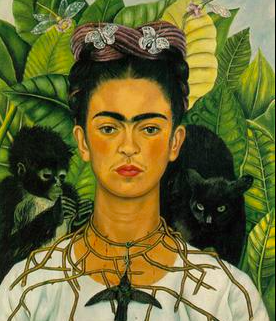Misapplying appropriation, co-optation, commodification & fetishization
The recent social media discussion over the work and legacy of Frida Kahlo, while somewhat interesting and entertaining, is in many respects disappointing. Some criticism argues that, because Kahlo came from a privileged upper class family, was comparatively light-skinned, and was not purely indigenous, that she had minimal right to use the iconography, imagery, and symbols associated with this culture. Even worse that Kahlo’s work harmed people of indigenous or Mestizo origins and was engaging in cultural appropriation.
Over the past several decades many people, organizations, and events have been accused of appropriating, co-opting, and fetishizing the symbols, icons, imagery, and styles of marginalized groups in order to commodify their work from which they profit. The appropriation, etc. critique, is especially used to criticize creative pursuits including cooking, dance, fashion, fiction, film, hair styles, music, theatre, and visual art.
A lot of this critique of cultural appropriation is appropriate. Examples might include white rappers raised in the suburbs who sing songs with African American Vernacular English, nonindigenous performers wearing Native American regalia, and people with no connection to the Holocaust tattooing themselves with numbers used by the Nazis in internment camps.
However, sometimes this type of labelling is done by casual observers and activists with varying degrees of expertise, especially by people who have minimal knowledge in the subject matters that they feel compelled to voice their opinion.
The appropriation etc. argument, similar to the lived experience one, implies that regardless of the quality of the work, so-called “outsiders” should not borrow cultural symbols and only people, etc. with direct roots in the cultures, ethnicities, nationalities, races or religions (i.e., “Insiders”) should be allowed to create works using the icons, etc. of the marginalized groups that they belong to or come from.
All told, accusing an artist, etc. of appropriation, etc. is basically suggesting that they are engaging in cultural insensitivity and distorting the original meaning of the symbols, icons, and styles they use in their work.
These charges, however, are frequently applied to individuals, etc. in a haphazard way. For example, when a well-known and respected graffiti writer or street artist, borrows images, symbols or conventions from certain ethnic or racial groups, etc. rarely are they accused in the same manner as artists who show their work in galleries or museums. Likewise, few people voice concerns over appropriation, etc. when their friends or acquaintances adorn their bodies with Japanese sleeve tattoos, or Nordic or Maori symbol tattoos.
In many cases using the labels of appropriation etc. is justified, but in lots other situations the evidence supporting the charges is not present, it’s flimsy, and/or the logic surrounding the charges is seriously muddled.
Why should we care when this kind of critique is made?
Clearly there are more important challenges facing the world, but hurling the accusation of appropriation, etc. against creative people and organizations has the following interrelated negative consequences:
First, it frequently minimizes the hard work of creators.
Second, it implies that “outsiders” work is theft or unimportant.
Third, it diminishes the creativity of the work of the artist, writer, dancer, etc.
Fourth, the words appropriation, co-optation, commodification, and fetishization are subjective terms.
Fifth these labels are typically misapplied, or not applied correctly.
Sixth, using these terms it is often a manifestation of political correctness.
Seventh, it fails to acknowledge the resources that goes into producing a piece of work.
Eighth, the harm that the creative person is rarely specified.
Ninth, it ignores the realization that all creative work is derivative, and,
Tenth, this kind of criticism is frequently overly simplistic and plays into the current cancel culture trend.
Why then does this occur?
I think that the rush to criticize “outsiders” with appropriation, etc. can be linked to three principle reasons.
Judging from the criticisms, is It seems as the criticism does not reflect a deep understanding of the history of the creative activity that they are maligning.
Meanwhile, ease of access to social media, has enabled opine no matter how uninformed their opinions are.
Few critics understand the nature of creation. Almost all creative work is either consciously or unconsciously derivative (see, for example, Austin Kleon’s Steal like an Artist). People who understand this principle are even encouraged to understand their predecessors so they can build upon it.
The fact that a person can label an action engaged in by others as expropriating someone else or a culture is not sufficient. There should be concrete evidence and nuanced argumentation.
How can this situation be best addressed?
The frequent criticism that a person, organization or event is an example of appropriation, etc. should be challenged. It’s too simple to accuse an individual , etc. with this charge. The biggest way to combat this charge it to become knowledgeable, beyond a simple Wikipedia entry, about the subject area in ways the arm chair critic is not.
Photo Credit
Frida Kahlo,
Self-Portrait with Thorn Necklace and Hummingbird (1940),
Harry Ransom Center







 Creative Commons
Creative Commons


